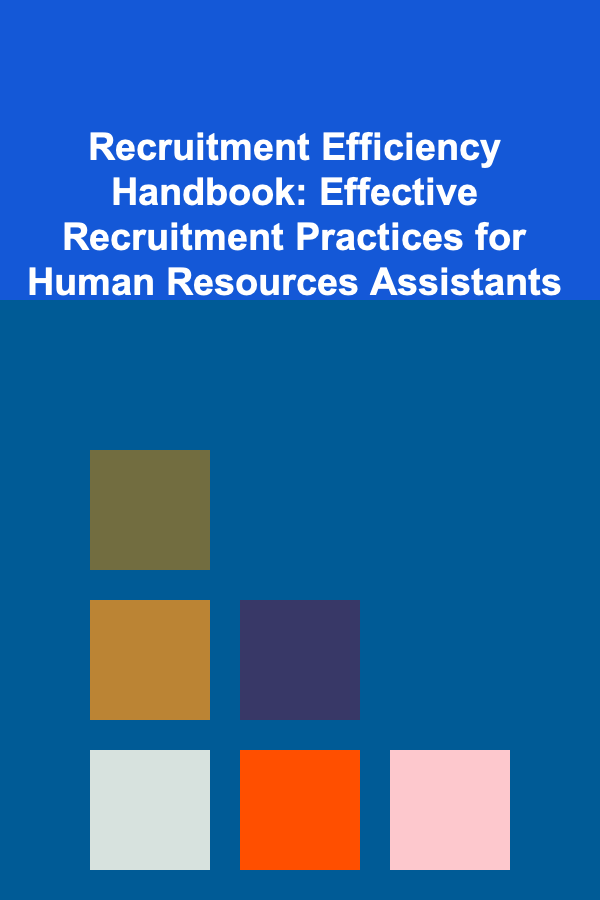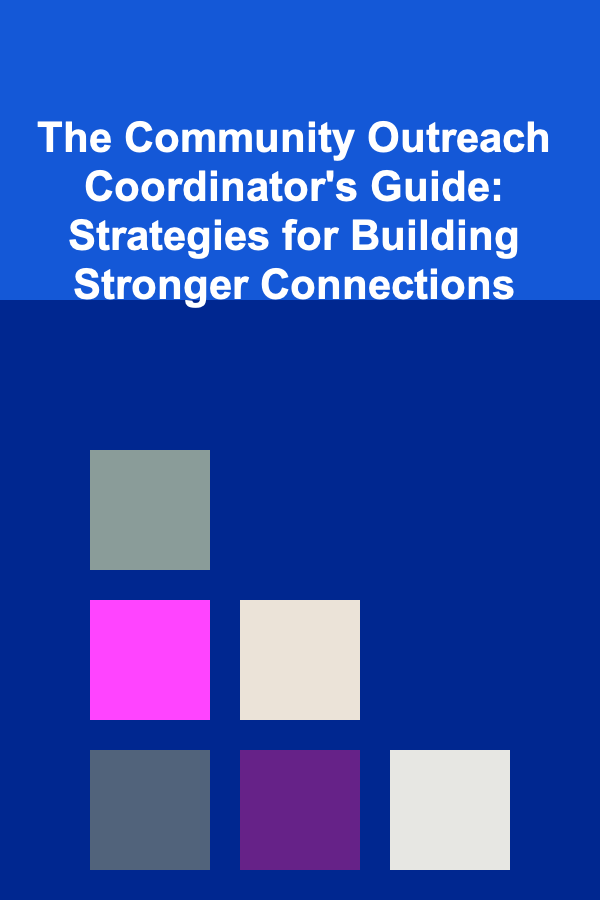
Recruitment Efficiency Handbook: Effective Recruitment Practices for Human Resources Assistants
ebook include PDF & Audio bundle (Micro Guide)
$12.99$5.99
Limited Time Offer! Order within the next:

Recruiting top talent is one of the most critical tasks for Human Resources (HR) departments. A successful recruitment process not only attracts skilled professionals but also fosters a positive employer brand, reduces turnover rates, and ensures that the company thrives. As HR assistants, you are often at the heart of the recruitment process, managing key administrative tasks, assisting with candidate interactions, and supporting hiring managers. This handbook will dive deep into the effective recruitment practices HR assistants should adopt to enhance recruitment efficiency.
Understand the Hiring Needs Thoroughly
Before diving into the recruitment process, it's essential to have a clear understanding of the role and the specific needs of the hiring department. Often, HR assistants are the first point of contact for job openings, so gaining a comprehensive understanding of the job description (JD), required qualifications, and the team's culture is vital.
Key Steps for Understanding the Hiring Needs:
- Collaborate with Hiring Managers: Schedule a meeting with the hiring manager to discuss the job role, required skills, and desired qualifications. Clarify whether there are any non-negotiables or room for flexibility in the job description.
- Understand the Team Culture: In addition to the technical qualifications, understand the team dynamics and culture to ensure that the right candidate will fit into the work environment.
- Ask Key Questions: What are the top three priorities for the role? What soft skills are needed? What does success look like in this position?
Why This Is Important:
Having a clear and aligned understanding of the role helps you create effective job postings, screen candidates efficiently, and present a well-rounded picture of the job to potential candidates.
Create Effective Job Postings
Job postings are the first interaction candidates have with the company. A clear, concise, and attractive job posting can significantly impact the quality and volume of applications you receive. As an HR assistant, crafting a compelling and accurate job description is crucial.
Key Tips for Crafting Effective Job Postings:
- Be Clear and Specific: Use clear language that accurately conveys the role's responsibilities and requirements. Avoid vague terms and ensure that the job posting provides a realistic picture of what candidates can expect.
- Highlight Company Culture: Share what makes the company unique. Highlight its values, work environment, and benefits. Candidates are more likely to apply to companies whose values align with theirs.
- Include Essential Keywords: Use keywords relevant to the job and industry. Not only does this improve the visibility of your job posting in search engines, but it also ensures you attract the right candidates.
- Use a Structured Format: Organize the job description into easily digestible sections, such as job summary, key responsibilities, required qualifications, and desired qualifications.
Why This Is Important:
An effective job posting attracts qualified candidates and saves time in the recruitment process. It also helps candidates self-assess their fit for the role before applying, reducing mismatches.
Source Candidates Strategically
While job postings are an essential tool for attracting candidates, relying solely on them is not enough. HR assistants should use multiple sourcing channels to ensure a diverse pool of applicants. The goal is to reach as many qualified candidates as possible to maximize your chances of finding the right fit.
Key Channels for Sourcing Candidates:
- Job Boards: Popular platforms like LinkedIn, Indeed, Glassdoor, and niche job boards offer a broad reach. These platforms can help you find candidates with the right skills and qualifications.
- Social Media: Use platforms like LinkedIn, Twitter, Facebook, and Instagram to share job openings. Social media is particularly effective for targeting passive candidates---those who may not be actively job hunting but could be enticed by the right opportunity.
- Employee Referrals: Encourage current employees to refer qualified candidates. Referral programs often result in higher-quality candidates and a smoother hiring process.
- Talent Pools and Databases: Build a talent pipeline by maintaining a database of previous applicants and candidates you've interacted with. Regularly update the pool by keeping in touch with potential candidates for future openings.
- Recruitment Agencies: In certain industries or for specialized roles, collaborating with a recruitment agency can expedite the hiring process and give you access to a broader talent pool.
Why This Is Important:
Diversifying your sourcing strategy reduces the risk of relying on a single channel that might not deliver the best candidates. It increases the likelihood of finding high-quality candidates faster.
Implement an Efficient Screening Process
Screening resumes and applications is often one of the most time-consuming tasks in recruitment. To improve efficiency, HR assistants must implement a structured and consistent screening process that filters out unqualified candidates while highlighting the most promising ones.
Key Screening Practices:
- Use an Applicant Tracking System (ATS): ATS software helps automate the initial stages of screening by sorting resumes based on keywords, skills, and qualifications. This can save a lot of time by eliminating candidates who don't meet the basic requirements.
- Create a Screening Checklist: Develop a checklist based on the job description and the must-have qualifications. This ensures that you evaluate each candidate consistently and don't miss any essential criteria.
- Screen for Soft Skills: While technical qualifications are important, don't forget to assess soft skills like communication, teamwork, and problem-solving. These are often just as crucial for success in a role.
- Phone Interviews: Conduct brief phone interviews to assess the candidate's communication skills, professionalism, and motivation. This helps you decide whether they are worth bringing in for an in-depth interview.
- Assess Cultural Fit: While screening, also keep an eye on how the candidate aligns with the company culture. A great technical fit doesn't always translate into a good team fit.
Why This Is Important:
An efficient screening process helps identify top candidates quickly, eliminating the need for extensive rounds of interviews with underqualified applicants. It also helps reduce bias and ensures a consistent and fair evaluation process.
Streamline the Interview Process
Once you've screened the candidates, the next step is to organize interviews. The interview process is an essential part of recruitment, as it allows you to assess the candidate's skills, experience, and cultural fit in a more detailed manner. However, scheduling and conducting interviews can be time-consuming. HR assistants can streamline this process to maximize efficiency.
Key Practices for Streamlining Interviews:
- Standardize Interview Questions: Develop a set of core interview questions that focus on the key skills and qualities needed for the role. Standardizing questions ensures consistency across interviews and makes it easier to compare candidates.
- Coordinate Efficiently: Use scheduling tools like Calendly or Outlook to coordinate interview times with candidates and hiring managers. This minimizes back-and-forth communication and avoids scheduling conflicts.
- Panel Interviews: If applicable, organize panel interviews where multiple stakeholders are present. This speeds up the decision-making process by gathering different perspectives simultaneously.
- Evaluate with a Scoring System: Create a rubric or scoring system to evaluate each candidate on a range of criteria. This provides an objective way to compare candidates' strengths and weaknesses.
Why This Is Important:
An organized interview process ensures that you can assess candidates effectively and make informed decisions. It also makes the process faster, reduces delays, and creates a more positive experience for both candidates and hiring managers.
Provide a Positive Candidate Experience
The recruitment process is not only about finding the right candidate but also about ensuring a positive experience for all applicants, whether or not they are hired. A positive candidate experience helps build a strong employer brand and can lead to successful future hires, even if the candidate doesn't get the role this time.
Key Elements of a Positive Candidate Experience:
- Clear Communication: Keep candidates informed at every step of the process. Whether it's acknowledging receipt of their application, scheduling interviews, or providing feedback, clear communication shows respect for their time and effort.
- Respectful and Timely Responses: Always respond promptly to candidate inquiries. Delays in communication can create frustration and reflect poorly on the company.
- Provide Constructive Feedback: If a candidate isn't selected, provide constructive feedback where appropriate. While this can be delicate, it's an opportunity to help candidates improve and build goodwill for your organization.
Why This Is Important:
A positive candidate experience helps you build a strong reputation as an employer of choice. It can lead to candidates recommending your company to others, even if they weren't selected, and it helps you maintain a strong talent pool for future openings.
Continuously Evaluate and Improve the Recruitment Process
The final step in ensuring recruitment efficiency is to continuously evaluate and improve your processes. Recruitment strategies and tools evolve, and staying updated with the latest trends can help you stay ahead of the competition.
Key Practices for Continuous Improvement:
- Track Metrics: Measure key metrics such as time-to-hire, cost-per-hire, and quality of hire. Analyzing these metrics helps you identify areas of improvement and optimize your recruitment strategy.
- Collect Feedback: Regularly ask hiring managers and candidates for feedback on the recruitment process. Use this feedback to refine your approach and eliminate any inefficiencies.
- Stay Updated on Trends: The HR field is always evolving. Attend webinars, read industry blogs, and engage with professional networks to stay informed about new tools, technologies, and best practices in recruitment.
Why This Is Important:
Continuous improvement ensures that your recruitment process remains efficient, effective, and aligned with the organization's goals. It also helps you adapt to changing hiring needs and stay competitive in the talent market.
Conclusion
Recruitment efficiency is crucial for HR assistants who aim to bring top talent into their organization. By following these effective recruitment practices---from understanding hiring needs to continuously evaluating your process---you can streamline operations, save time, and ensure that your company attracts the best candidates. Efficiency in recruitment not only accelerates the hiring process but also enhances the overall quality of hires and strengthens the company's workforce. Embrace these strategies, and your recruitment process will become more organized, effective, and ultimately successful.

How to Achieve the Best Bathroom Makeovers on a Budget
Read More
How to Build a Strong Translation Portfolio to Get Part-Time Jobs
Read More
How to Conquer Your Fear of Animals in the Wild
Read More
How to Control Pet Fleas and Ticks in Your Home
Read More
How to Understand and Manage Your Credit Card Debt
Read More
The Community Outreach Coordinator's Guide: Strategies for Building Stronger Connections
Read MoreOther Products

How to Achieve the Best Bathroom Makeovers on a Budget
Read More
How to Build a Strong Translation Portfolio to Get Part-Time Jobs
Read More
How to Conquer Your Fear of Animals in the Wild
Read More
How to Control Pet Fleas and Ticks in Your Home
Read More
How to Understand and Manage Your Credit Card Debt
Read More